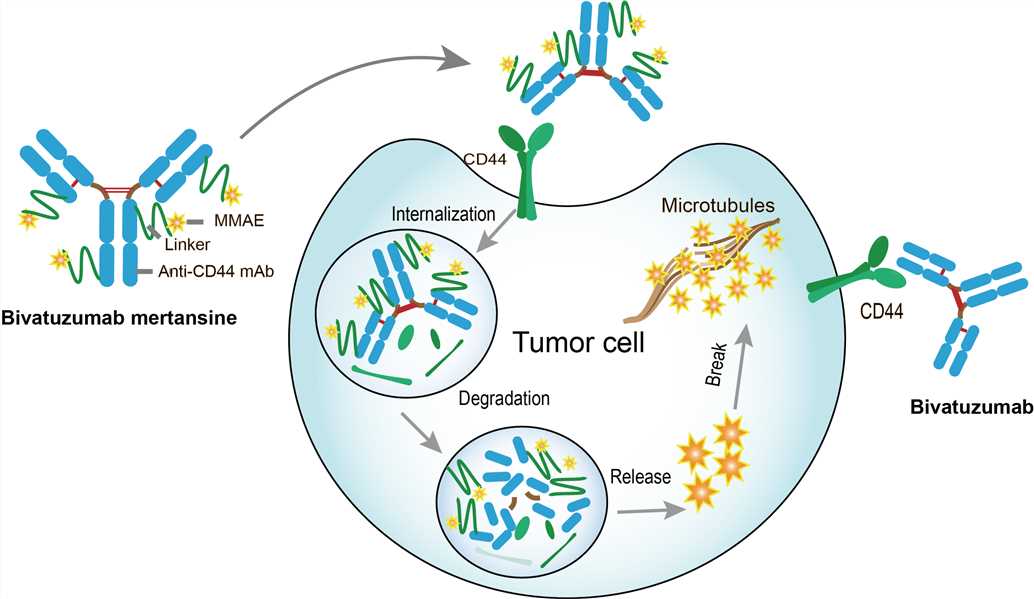Bivatuzumab Mertansine Overview
Introduction of Bivatuzumab mertansine
Bivatuzumab mertansine, also known as BIWI 1, is an antibody-drug conjugate, which is composed of a monoclonal antibody targeting human CD44v6 and microtubule toxin mertansine. CD44v6 is a variant of cell surface adhesion receptor CD44, which is strongly expressed in squamous-cell carcinoma (HNSCC). Mertansine, also known as DM1, is a derivative of maytansine, which can bind to tubulin and inhibit the assembly of microtubules, resulting in cytotoxicity. Bivatuzumab mertansine was developed by Boehringer Ingelheim to treat squamous cell carcinomas, such as Head and neck cancer. In 2006, the results of phase I trials of safety, pharmacokinetics and maximum tolerable dose of bivatuzumab mertansine were reported. It showed that the main toxicity of bivatuzumab mertansine was skin toxicity. In 2007, the safety and pharmacokinetics of bivatuzumab mertansine in patients with CD44v6 positive metastatic breast cancer were reported. This result showed that bivatuzumab mertansine had a stable effect on CD44v6 positive metastatic breast cancer. But in 2008, it was reported that bivatuzumab mertansine could bind to CD44v6 on skin keratinocytes, resulting in severe skin toxicity, so, the development of bivatuzumab mertansine was discontinued. In a combined treatment trial in 2012, the combination of bivatuzumab mertansine and fractionated irradiation could significantly improve local tumor control. This combination of drugs makes bivatuzumab mertansine play a role in tumor treatment again.
Mechanism of Action of Bivatuzumab mertansine
Bivatuzumab mertansine is a kind of mitosis inhibitor, composed of IgG type monoclonal antibody targeting CD44 and tubulin inhibitor DM1, conjugated by disulfide linker. CD44 is a kind of cell adhesion molecule, which is mainly involved in the interaction between cells and matrix. CD44 also plays a role in the invasion and metastasis of tumor cells because they can participate in the interaction between cells. Mertansine, a maytansine derivative containing disulfide bonds, is an effective cytotoxic molecule against cell mitosis. Maytansine is the first ansha macrolide antibiotic with antitumor activity. The main mechanism of maytansine is to block the polymerization of tubulin and block the cell cycle in G2/M phase by binding to vinblastine sites on tubulin, thus inhibiting the progress of cell mitosis and leading to the withering of fine cells. Because of the lack of selectivity of maytansine to kill tumor cells, it is often conjugated with specific monoclonal antibodies for the treatment of tumors. Upon administration, the monoclonal antibody part of bivatuzumab mertansine binds to CD44 expressed on the surface of tumor cells. Internalization occurs when antigens and antibodies bind, and drugs are delivered to the cytoplasm. The linker between DM1 and antibody cleaves and binds to tubulin in the cell to prevent cell division.

Fig 1. Mechanism of Action of Bivatuzumab mertansine
What We Provide
Therapeutic Antibody
Bivatuzumab
We provide high-quality Bivatuzumab for use in WB, FC, IP, ELISA, Neut, FuncS, IF and most other immunological methods. For lab research use only, not for diagnostic, therapeutic or any in vivo human use.
For research use only. Not intended for any clinical use.
This site is protected by reCAPTCHA and the Google Privacy Policy and Terms of Service apply.

